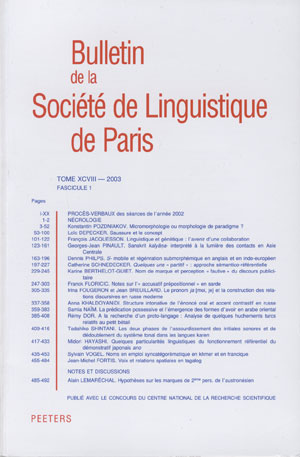 previous article in this issue previous article in this issue |

Preview first page |
Document Details : Title: Le mouvement associé en rma, une langue sino-tibétaine Author(s): SIMS, Nathaniel A. Journal: Bulletin de la Société de Linguistique de Paris Volume: 118 Issue: 1 Date: 2023 Pages: 289-305 DOI: 10.2143/BSL.118.1.3292786 Abstract : La catégorie grammaticale du «mouvement associé» (MA) est récemment devenue un sujet d’intérêt dans la linguistique transhimalayenne (sino-tibétaine). Cet article présente une enquête préliminaire sur le MA dans la langue rma (Qiang), ici spécifiquement sous la variété yonghe. La langue rma est relativement bien documentée, et les enquêtes antérieures ont démontré que le MA est absent de la plupart des variétés de rma, avec quelques exceptions, comme en yonghe rma. Cette enquête a montré que le MA est plus répandu qu’on ne le croyait auparavant, avec l’attestation de marques de MA, sous divers degrés de grammaticalisation, dans chacun des cinq comtés dans lesquels la langue rma est parlée. On a également observé pour presque toutes les marques de MA qu’elles sont apparemment liées aux verbes indépendants de mouvement, et que le MA de sens itif est préféré au MA de sens ventif dans les textes examinés. The grammatical category of 'associated motion' (AM) has been a topic of recent interest in Trans-Himalayan (Sino-Tibetan) linguistics. This paper provides a preliminary survey of AM in Rma (Qiang), with specific emphasis on the Yonghe variety. Although Rma is relatively well documented, AM is a relatively recent comparative concept in typology. Previous studies found that AM is absent in most Rma varieties, with few exceptions like in Yonghe Rma. This paper found that AM is more widespread in Rma varieties than previously believed, with evidence of AM markers, under varying degrees of grammaticalization, from each each of the five counties where Rma is spoken. It also found that almost all AM markers appear to be related to independent verbs of motion, and that there is a preference for itive AM relative to ventive AM in the surveyed texts. Die grammatische Kategorie der 'verknüpften Bewegung' (VB) ist ein Thema, das vor kurzem im Bereich der transhimalajischen (sinotibetischen) Sprachwissenschaft viel Interesse erwacht hat. Dieser Aufsatz stellt eine vorläufige Umfrage der VB in Rma (Qiang) dar, mit Betonung auf der Yonghe-Varietäten. Obwohl Rma sorgfältig dokumentiert ist, ist die VB als vergleichendes Konzept in der Typologie relativ neu. In vorherigen Untersuchungen wurde gefunden, dass die VB, abgesehen von einigen Ausnahmen, wie Yonghe Rma, von den meisten Varietäten von RMA abwesend ist. In dieser Untersuchung wurde es festgestellt, dass VB in den Varietäten von RMA weiter verbreitet ist, als man zuvor geglaubt hat, mit Anzeichen der unterschiedlich grammatikalisierten VB-Markern, aus jedem der fünf Kreise, wo Rma gesprochen ist. Es wurde auch festgestellt, dass fast alle VBMarkern mit unabhängigen Bewegungsverben verbunden sind, und dass itive VB im Vergleich zur ventiven V, in den analysierten Texten bevorzugt ist. |
|


